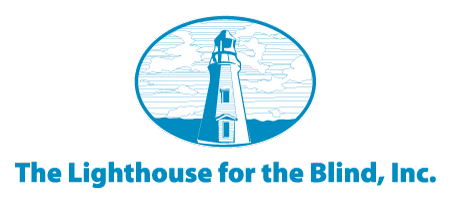Paul Ducharme – 2018 Employee of the Year

2018 Employee of the Year Paul Ducharme
Paul Ducharme’s upbeat personality and sense of humor comes through the moment you meet him. Originally from Connecticut, Paul moved from Boston to Seattle in 2008 to work for The Lighthouse for the Blind, Inc. Ten years later, Paul was elected by his peers as the 2018 Raymond. W. Haman Direct Employee of the Year recipient. He had the opportunity in April to attend the National Industries for the Blind (NIB) Conference in Virginia with other employees of the year from associated NIB agencies.
“The Lighthouse is a wonderful place, it’s a community. The level of accessibility can’t be beat, you can access lots of different services, have the opportunity to learn new skills, different machines, and cross-train. There’s also a lot of fun going on here!” he says.
Paul first became aware of the Lighthouse in the 90’s when he was at the annual DeafBlind Retreat on Hood Canal in Seabeck, WA. When he visited the Lighthouse on a day tour, he learned there were DeafBlind people running machines, and it left an impression on him.
“I grew up working; it’s part of my character,” Paul says. “I was used to doing office work, but when I lost my vision, office work lost its purpose for me.” Working at the Lighthouse was Paul’s first experience in a manufacturing setting. “I’m not much of a handyman; I wasn’t even very good at hammering in a nail,” he says. “But now I’m pretty good as a machinist.” Paul spends most of his time running the clicker press, which is used to cut felt. Initially he was a bit nervous running a machine, but once he was properly trained and realized it was safe, he got used to it. In the past three years, Paul has also become an everyday braille user by taking advantage of the braille literacy classes at the Lighthouse. Paul’s goal is to become a braille instructor in the future.

Machine Operator Aerospace and Direct Employee of the Year, Paul Ducharme, at his workstation in the Seattle facility.
Along with braille, Paul uses pro-tactile American Sign Language (ASL) to communicate. “People always think that being DeafBlind is a quiet experience, but once you connect through touch, it’s energizing.” It’s not a matter of faster communication, but more nuanced communication. Pro-tactile ASL uses techniques that give more information on your back or legs.
“When I’m presenting to a group, for example, there’s a pro-tactile interpreter who will stand behind me and give me visual or auditory information from the audience, and let me know whether they’re smiling or frowning or yawning. I am able to have a better rapport with the audience, and adjust my presentation accordingly. Before, I didn’t know what was going on with the audience at all.”
Though more and more people who are DeafBlind are familiar with the Lighthouse and encouraged to move to the Seattle area to join the DeafBlind community, Paul would love if the Lighthouse DeafBlind Program could exist in every state. “There are people who can’t pick up and move, and it would be great to see the Lighthouse model everywhere.”



